How To Care For a Leopard Gecko
Introducing The Leopard Gecko
Nocturnal in nature, the leopard gecko is indigenous to the desert areas of
Asia, and is common to Pakistan, northwest India, and certain areas of Iran.
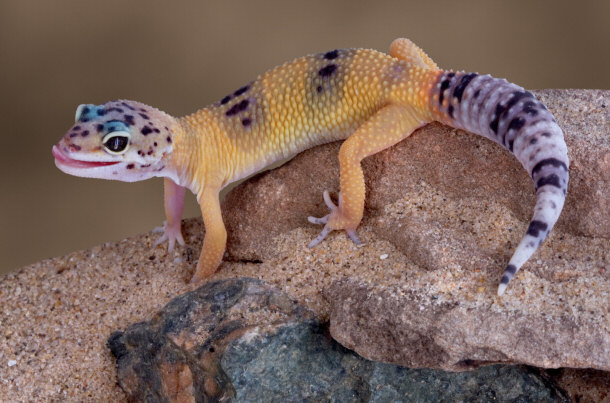
Leopard geckos are unique over other geckos as they can move their eyelids.
Geckos Live About as Long as a Dog When Raised in Captivity
The leopard gecko, with its distinctive spots, has proven to be a popular pet
when it is raised in captivity. The animal, which was first noted as a species
by zoologist Edward Blyth in 1854, makes a good pet as it usually lives alone in
its native habitat. Geckos live as long as 20 years in the wild and about 10 to
14 years when raised in captivity.
Characteristic Traits
The lizardís head is triangularly shaped and it possesses a notable tail in
which fat is stored. The patterned spots on the lizard's bumpy skin camouflage
the animal on rocky and dry terrains in his native lands. Because the gecko
needs minimal care, you can leave it alone for several days without too much
worry. The lizard does not emit any malodorous smells nor does it require a
sizable amount of space.
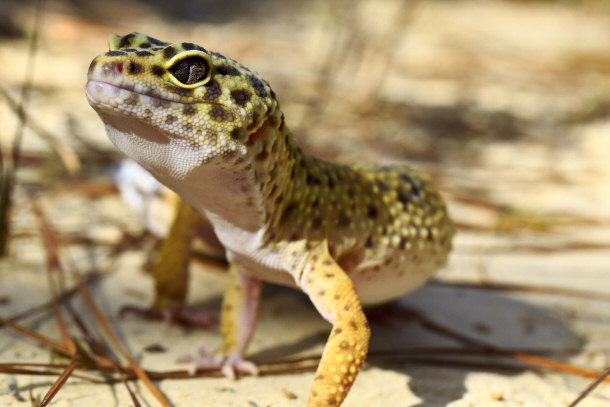
Leopard geckos have exceptional abilities to see and smell, both which they
use to capture insects or prey in their natural habitats. Baby leopard geckos
are usually about 3 inches in length while adults are around 9 to 10 inches
long.
The Leopard Gecko Lizard - A Low Maintenance Pet
Therefore, the leopard gecko is one pet that wonít cause you too much difficulty
when it comes to feeding and caring for it. You just have to make sure that you
have the animalís habitat established and that the proper lighting and heating
adjustments are made.
Gecko Pet Care Essentials
All in all, you'll need to outfit your leopard gecko with the following basic
gecko essentials:
-
10, 15, or 20-gallon tank, depending on whether youíll be housing one,
two, or three geckos
- Substrate, preferably alfalfa pellets as geckos tend to eat the material
- Food, such as crickets, mealworms, wax worms, or pinkies (newly born
mice)
- shallow, non-tip water dish
- planter dish if you feed your gecko mealworms
- Calcium dust and a multivitamin supplement
- Non-toxic and artificial plants
- Under Tank Heater or UTH
- Thermometer
- Hygrometer or Humidity Gauge
- Hiding log or box.
The Gecko Habitat: Choosing a Terrarium Tank
A 10-gallon tank is recommended for one gecko while two geckos can reside in
a 15-gallon or 20-gallon habitat. Three geckos will require a terrarium that is
at least 20 gallons or more. Adorn the tank environment with branches, cork, and
small logs as well as artificial or non-toxic plants.
Temperature and Humidity Readings
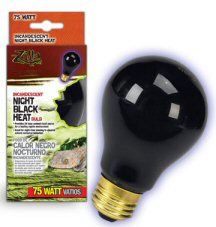 Ideally, the humidity should range between 30 and 40 percent and the
temperature in the tank should span between 80 to 85 degrees Fahrenheit. Set up
a basking area for your gecko that is set at around 95 degrees Fahrenheit. If
you have more than one gecko, then you'll want to include more than one basking
spot. Ideally, the humidity should range between 30 and 40 percent and the
temperature in the tank should span between 80 to 85 degrees Fahrenheit. Set up
a basking area for your gecko that is set at around 95 degrees Fahrenheit. If
you have more than one gecko, then you'll want to include more than one basking
spot.
To make sure you set up the tank correctly, a screen or mesh top should be
provided on the top of the terrarium to supply your pet with the proper
ventilation. You'll also need a thermometer to make sure that the temperature is
maintained and a hygrometer to measure the tank's humidity. An under tank heater
(UTH) can be set up to establish the proper temperature.
Humidity Requirements
Because geckos have specific moisture requirements when it comes to shedding,
you'll need to make use of a hygrometer to make sure they are met. Otherwise,
your lizard can suffer from dehydration. Also, a higher level of humidity can
cause your lizard to contract an infection. Again, the preferred level of
humidity is around 30 to 40%.
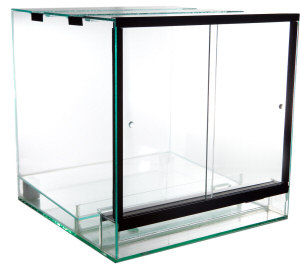 Setting Up the Tank Areas Setting Up the Tank Areas
In a one-gecko residence, you'll need to establish four primary areas - two
areas where he can hide or sleep, one for activity, and an area for basking.
Place such items as hide boxes, rocks that overlap, and pieces of curved bark in
the hiding areas and maintain open spots in the activity area. To promote
movement, set smooth wood pieces or rocks in your gecko's tank so he can easily
climb. The spot where your lizard basks should contain a flat rock beneath an
incandescent light.
Lighting Requirements
Lighting for the tank will be needed for approximately half the day. Leopard
geckos are nocturnal creatures. Therefore, you don't have to include UVB lights
as you do for other lizards. Use a black heat bulb or a heater made of ceramic
instead. Again, for the lizard's basking spot, an incandescent bulb will
suffice. Include edible alfalfa pellets as a substrate in the tank as some
lizards tend to eat the material.
Use Automatic Timers to Make Sure Your Geckoís Lighting Requirements are Met
The lighting cycle during the summer months should include 14 hours of light
while wintertime necessitates 12 hours of illumination. Automatic timers can be
used to make sure that the tank receives the required light. Again, use black or
red heat lamps and set the light bulbs outside the terrarium over the lid.

Leopard geckos prefer the subtler lights as UV lighting is just too bright and
disruptive to the nocturnal nature of the animal.
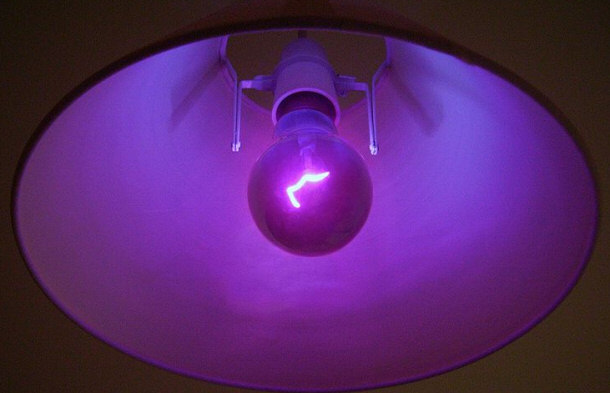
The excessive lighting can
cause your lizard to become anxious or overstressed.
Heating Sources
Recommended heat sources, used for maintaining the tank's environmental
temperature, can include one or more under tank heaters (UTHs) as well as
overhead heating sources. Secondary heating sources are used to supply extra
heat to spots like the basking area and may be represented by either a red or
black basking light.
Gecko Hygiene and Care
Establishing a Shed Box
Leopard geckos regularly shed. Therefore, you'll need to supply your lizard
friend with a moisture-rich shed box in which he can shed his skin. A hide box
containing sphagnum moss, dampened soil, or peat moss is a good choice. When
leopard geckos do shed, they get rid of all of their skin at one time. Baby
geckos shed more frequently than adult geckos do.
You'll note that your gecko is ready to shed as his colors will take on a
duller hue before turning white. The white color is your cue that shedding is
next. The gecko devours the skin he sheds during the process. This response is
necessary in the wild to keep the lizard protected from predatory enemies.
Donít Raise Two Male Geckos in the Same Tank
If you do raise more than one gecko, donít put two or more males together in
a tank or pair a gecko with another type of reptile. Rather, raise two gecko
females together, or two females and a male. Male geckos are especially
territorial.
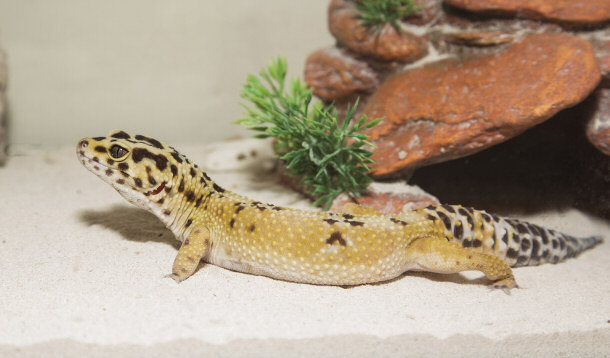
Therefore, they can become quite aggressive if they are forced to
live with one another for any period of time. So, as long as you remember the
aforementioned caveats, you can include more than one gecko in a tank.
Nutritional Requirements
The gecko diet often consists of lizard cuisine choices like crickets,
mealworms, or wax worms. Most geckos will not eat prey that is dead. Because
leopard geckos like to hunt their prey, live crickets are often used as a food
source when a gecko lives inside an enclosed environment or a terrarium.
Crickets that are gut-loaded or that have been just fed are special treats to
geckos. Make sure that the cricket food is no bigger than 50% of the length of
the lizard's head. If your gecko is still a baby, feed it every day and when it
matures, you can skip a day. Leopard geckos also enjoy pinkies (or just-born
baby mice).
 Crickets and Mealworms: Standard Gecko Fare Crickets and Mealworms: Standard Gecko Fare
While pinkies are indeed a treat, most gecko owners tend to feed their gecko
either crickets or mealworms most of the time. Geckos enjoy eating crickets as
live insects provide more of a stimulus and interest for your pet, supporting
its predatory instinct and diet at the same time. Plus crickets also provide
better nutrition than mealworms. The chirping insects contain extra moisture,
protein, vitamin C, and necessary calcium. A cricket's slim exoskeleton is also
easier for the lizard to eat and digest as well.
Why Some Owners Prefer to Feed Mealworms Instead
Still, some gecko owners rather give their lizards mealworms as crickets can
definitely annoy some people with their chirping. Plus, mealworms can't escape
like crickets can. Buy mealworms in bulk and they will last for weeks,
especially if theyíre refrigerated.
Mealworms
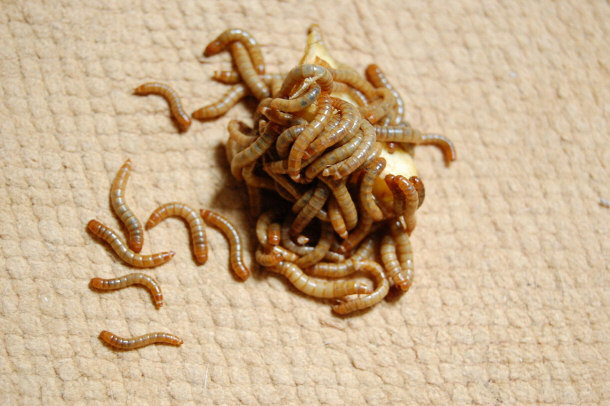
By MarioM (Own work),
via Wikimedia Commons
Also, you can leave mealworms in your
gecko's tank, so he'll have a constant supply of sustenance. That way, you only
need to feed your gecko weekly, provided the food dish is big enough to hold his
nourishment. Place the mealworms in four to six inch plant saucers, depending on
the size of your gecko's habitat.
Make Sure that Your Gecko Receives Enough Calcium and Vitamin D3
Itís important to make sure that the lizard receives enough vitamin D3 and
calcium from their diet. Usually, the nutrients can be obtained in the wild
through insects, such as spiders, moths, or ants. When added to the diet of a
pet gecko, the nutrients are dusted on the animalís food with a fine calcium
powder that includes vitamin D3.
Leopard Gecko Who has Lost Its Tail But it is Growing Back
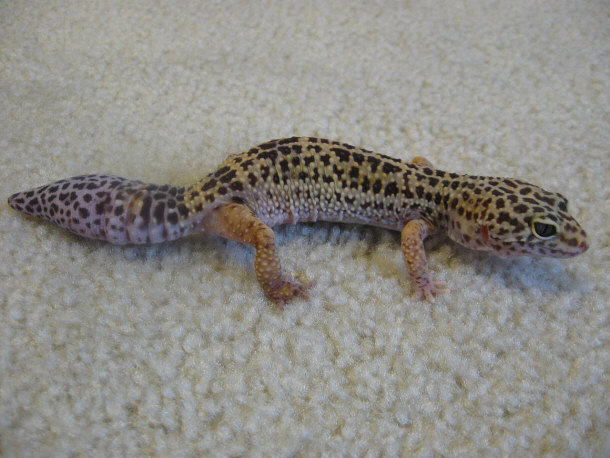
So, make sure you provide a dusting of calcium
whenever you feed your lizard and give him a multivitamin for supplementation
once a week.
Replace Your Geckoís Water Daily
The water you provide your pet should be free of chlorine and therefore
filtered and fresh. Change it daily and pour it in a shallow non-tipping dish.
Donít use a deep water dish as it can present a drowning hazard for your pet.
Thanks for reading, and I want to thank James from
secrets to save your
leopard gecko for helping me with some of this information.
Pets
Top Lists:
18 Richest Animals in the World
15 Exotic Pets You Could Own Today
Top 20 Common Substances That Are Toxic to Cats and Dogs
Informational:
Animal Actors: Pets in the Film, TV, and Print Industry
Caring for a Yorkshire Terrier: Facts You Should Know
Caring for a Pig as a Pet: The Pot-bellied Pig and the Micro Pig
Difference Between a Cat Person And a Dog Person
Should You Microchip your Cat or Dog?
How to Raise and Care for Pygmy Goats
Caring for Unique Pets: The Leopard Gecko
Use Food-Grade Diatomaceous Earth to Kill Fleas Naturally
Dogs:
Top Lists:
Top 15 Dog Breeds For Home Protection
15 Fascinating Facts About The Mastiff
Informational:
How To Teach Your Dog to Hunt for Truffles
Caring for an English Bulldog: Tips and Basic Info
Cranial Cruciate Ligament (CCL) Tears in Dogs: Treating the Injury
How To Keep Your Dog free of Heartworm Disease
Dog With Separation Anxiety?
Cats:
Top Lists:
Top 6 Qualities in an Awesome Cat
Informational:
How to Control Fighting Felines
How to Get Your Cat to Exercise
Fish:
Fish 101 for the Hobbyist: The Fishís Body and Senses
Buying a Saltwater Aquarium: What You Need to Know
Graduating to a Saltwater Tank
|